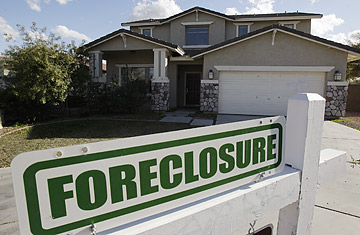
Slowing foreclosures will help the housing market more than helping people pay mortages
You might have noticed a particular word missing from the speech President Obama gave on Wednesday in rolling out the Administration's massive housing-rescue plan. That word is "subprime." That might ring a little odd, considering how religiously we've been talking about the "subprime mortgage crisis" — all the loans made to borrowers with bad credit who couldn't really handle them. The thing is, subprime isn't the entire story. In fact, looking forward, it's not even the biggest problem. While the raw percentage of subprime loans in delinquency and foreclosure still far outstrips any other sort of mortgage, the types of loans that are now going downhill the fastest are ones that were generally sold to more credit-worthy borrowers. (See the top 10 buzzwords of 2008.)
What's changed? The economy. Subprime loans were written to the weakest borrowers, so they stumbled first, especially since many were set-up with an interest-rate spike after two or three years. In January, nearly 40% of all subprime loans were either behind on payments or in foreclosure. Now, though, with companies cutting back work hours and unemployment hitting 7.6%, borrowers of all stripes are running into trouble. "Originally, the loan product was driving a lot of the delinquencies," says Steve Berg, managing director of loan-tracker LPS Applied Analytics. "Now you have widespread house-price deterioration and people losing their jobs. If you lose your job, it doesn't matter if you have a good loan product, you still might not be able to make your payment."
It's easy to see the shift by looking at bands of FICO scores — a popular measure of a borrower's creditworthiness. In January, 18.58% of loans associated with a FICO score below 688 were delinquent by one measure — a large number, but just half a percent more than in December. By contrast, the number of delinquent loans in the top tier (752 or higher), jumped by nearly 7% in January. The overall percentage of problem loans remained small by comparison — the delinquency rate rose from 1.45% to 1.55% — but the quickening pace of homeowners falling behind on their payments signifies more trouble ahead. "Those are tomorrow's foreclosures," says Ted Jadlos, senior managing director of LPS, which provided the numbers from its database of 40 million home loans, which covers about 70% of all mortgages. (See 25 people to blame for the financial crisis.)
Among prime borrowers, those with jumbo mortgages — ones that have traditionally been for more than $417,000 — are seeing delinquencies accelerate the fastest. In January, 3.32% of such borrowers were behind on their payments, up from 1.75% in August. (That doesn't include the 1.1% of borrowers already in foreclosure.) Since Fannie Mae and Freddie Mac don't buy these large loans, it's been tougher for homeowners to refinance their way out of trouble — and the new housing-rescue package, which specifically excludes jumbo loans, won't do anything to change that dynamic.
Delinquencies are also getting much worse among holders of option adjustable-rate mortgages (option ARMs). These loans, typically made to borrowers with prime or near-prime credit scores, let soon-to-be homeowners pick from a menu of monthly payments — often including an option that didn't even keep up with the interest due. As home prices have fallen, the number of option ARM borrowers running into trouble has surged, with 15.25% of loans delinquent and another 7.46% in foreclosure. Some analysts think the problem in option ARMs could eventually rival the size of the subprime meltdown. (See pictures of crime in Middle America.)
In other words, the trauma is far from over. Just consider the uptick in the delinquency rate of loans written in 2003 and 2004. A borrower who falls behind on payments typically does so within the first two or three years, but now the problems are reaching ever further back. "These older vintages should be out of the woods, but they're not," says Jadlos. That's partly because dropping property values have driven homes, on average, down to what they cost four years ago. Add in all those home equity loans people used to free up cash, and you're left with a situation where more than 18% of homeowners now owe more than their house is worth, according to First American CoreLogic. When the crappy economy causes your household income to take a hit, good luck trying to refinance or sell.
Which means even if you didn't sign up for a subprime loan at the height of the housing bubble, the math can still come back to bite you. And it is.
